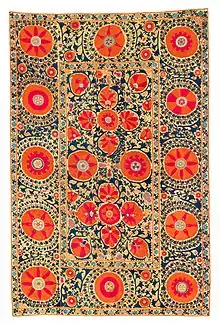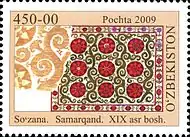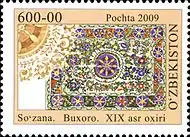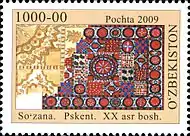Suzani (textile)
Suzani is a type of embroidered and decorative tribal textile made in Tajikistan, Uzbekistan, Kazakhstan and other Central Asian countries. Suzani is from the Persian سوزن Suzan which means needle. The art of making such textiles in Iran is called سوزندوزی Suzandozi (needlework). Suzanis are rather delicate and extremely few examples survive from before the late 18th and early 19th centuries. They belong, however, to a very ancient tradition. In the early 15th century, Ruy Gonzáles de Clavijo, the Castilian ambassador to the court of Timur (Tamerlane), left detailed descriptions of embroideries that were probably forerunners of the suzani.[1]

.jpg.webp)
| Part of a series on |
| Islamic culture |
|---|
| Architecture |
| Art |
| Clothing |
| Holidays |
| Literature |
| Music |
| Theatre |
Suzanis were traditionally made by Central Asian brides as part of their dowry, and were presented to the groom on the wedding day.[2] These hand-embroidered vintage suzanis are infused with the character that only comes from everyday use. The story of each of these suzanis is as rich as their colors and as intricate as the designs that cover their surfaces.[3]
Types
- Bukhara Suzani
- Khodjent Suzani (Khodjent, Tajikistan)
- Lakai Suzani
- Nurata Suzani, made in the town of Nurata in Uzbekistan.
- Piskent Suzani
- Samarkand Suzani
- Shakhrisabz Suzani
- Tashkent Suzani
- Ura Tube Suzani (Istaravshan, Tajikistan)
See also
- Kaitag textiles, embroidery style from Dagestan
- Tush kyiz
- Pateh, embroidered wool textile from Kerman province in Iran
References
Sources and external links
- Guide to Suzani by Barry O'Connell. Photographs of all types of suzanis.
- Article on suzanis
- Contemporary Uzbek suzanis by Marla Mallett. Includes details of embroidery techniques.
- "Splendid Suzanis, 2003, Saudi Aramco World
- All about suzani from Central Asia
- TRC Needles entry on suzanis.






.jpeg.webp)